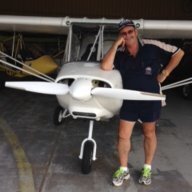Well in the last week I have flown a Jabiru J230 with the all new 6 cylinder engine 3 times for a total of 5.1 hours.
It is an absolute joy to fly and with the electronic panel giving very up to date information it is very easy to know what the engine is doing and when and as a result it is not hard to work out why.
Typical feature that I would expect to find and was not disappointed.
Smooth. The engine is smooth and gives excellent power in a steady consistent manner.
That sound. Not much more to say about that.
Climbs out at 70 knots comfortably @ 1000 ft/min 1 up and a cruise climb of 90 knots @ 700 ft/min 1 up.
20 ltrs/hour @ 2850 rpm for 110 to 115 indicated airspeed.
With a fuel capacity of 140 litres this thing can go a long way.
It flys like the only other Jabiru J230 that I have flown which is to say it feels like a good well finished aircraft with a comfortable finish that gives a good cocoon like feel inside the aircraft.
I must admit that I am not a fan of the Jabiru trim system but having said that it works.
70 knots over the fence and with 117 degrees of flap it is easy to trim for that 70 knots.
65 knots best glide speed and it is also easy to trim for that with the engine at idle. Hopefully I will never find out whether it is still ok with no engine at all.
It has a couple of teething troubles but they would be easy to sort and if it were my plane I would sort them sooner rather than later.
I guess only time will tell if Jabiru have gotten it right with this engine, as this is only the second engine and the first in a customer aircraft I guess anyone who flys it is a test pilot but I felt from a drivers point of view that it is a good well balanced airplane.
My first flight was an intro flight, although I had flown a J230 before I had not flown this one or a plane with this panel so a familiarisation flight and a few circuits with the CFI
Second flight was an hour and a half with a Senior instructor so I could revise some aspects of my flying with someone experienced along side me to keep an eye on things and kick me in the bum if I stuffed up. Stalls, tight turns etc.
Today was 2.6 hours Caboolture over the Bay Islands to Q1, then on to Boonah for a leg stretch and a Bannana. Then Gatton, Watts Bridge and home. Smooth clear skys and a ton of fun.
Positives.
The power in an RAA aircraft is awesome.
Fuel for power @ 20 litres per hour for 115 knots, I will take that any day and with the fuel capacity and carrying capacity this is a good touring aircraft.
Very tight finish giving a comfortable secure feel to the crew compartment.
Negatives
This plane flys a little left wing down and needs constant left rudder. It has less than 25 hours, of which I have flown 5 of them but still if I bought a new airplane, I would expect those two things to be sorted before I brought it home. After all it should be just a little bit of trim to fix both issues.
It is an air cooled engine, and as such requires more monitoring than a water cooled equivalent. To me this is not a problem as it just means that I am responsible for monitoring and adjusting my flying to suit the plane. Whether this is a good thing in a hire school environment remains to be seen.
On the first two flights it did tend to generate high EGT on number 4 at the POH cruise of 2800 rpm. With a little bit of trail and error we found that this was not a problem at 2850 and the POH is being amended to reflect this. This should have been discovered during test flying but as I say the driver needs to take some responsibility for his actions and understanding whet is happening up front helps.
Summary
If I were buying a new aircraft to go places and carry my passengers in what to them would feel like a real aircraft, then this aircraft would have to be on my must try list.








